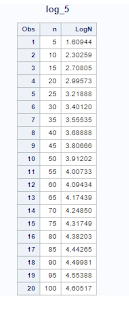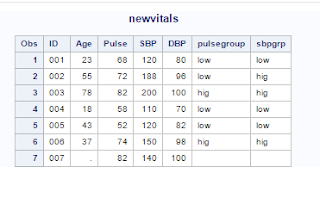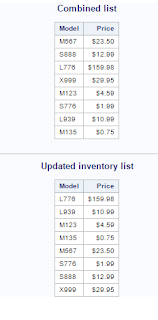Basic programs of SAS
Problem Statement
creating new data set using do statement
Code
Creating dataset
Program
Output
Problem Statement
Q 2 )Create and print a data set with variables N and Log N, where Log N is the natural log
of N (the function is LOG). Use a DO loop to create a table showing values of N and
Log N for values of N going from 1 to 20.
Code
Output
Problem Statement
Q 3 )Repeat Problem , except have the range of N go from 5 to 100 by 5.
Code

Poblem Statement
Q 4) Use an iterative DO loop to plot the following equation:
y = 3*x2 � 5*x + 10
Use values of x from 0 to 10, with an increment of .10. Copy the GPLOT statements
from Problem 8 or use PROC PLOT to display the resulting equation.
Code
Output
Problem Statement
Q 5 ) Use an iterative DO loop to plot the following equation:
Logit = log(p / (1 � p))
Use values of p from 0 to 1 (with a point at every .05). Using the following GPLOT
statements will produce a very nice plot. (If you do not have SAS/GRAPH
software, use PROC PLOT to plot your points).
Code
Output
Problem Statement
Q 6 )Generate a table of integers and squares starting at 1 and ending when the square
value is greater than 100. Use either a DO UNTIL or DO WHILE statement to
accomplish this
Code
Output
Problem Statement
Q 7),Using the SAS data set Hosp, create a temporary SAS data set called Monday 2002,
consisting of observations from Hosp where the admission date (Admit Date) falls on
a Monday and the year is 2002. Include in this new data set a variable called Age,
computed as the person�s age as of the admission date, rounded to the nearest year.
creating hosp data set
Code
Output
Problem Statement
Q 8),Print out the observations in the two data sets Inventory and New Products. Next,
create a new temporary SAS data set (Updated) containing all the observations in
Inventory followed by all the observations in New Products. Sort the resulting data
set and print out the observations.
6. Repeat Problem 5, except this time sort Inventory and New Products first (create two
temporary SAS data sets for the sorted observations). Next, create a new, temporary
SAS data set (Updated) by interleaving the two temporary, sorted SAS data sets.
Print out the result.*/
*Data set INVENTORY;
Code
Output
Problem Statement
Q 9 Using the SAS data set Survey 1, create a new, temporary SAS data set (Survey 1)
where the values of the variables Ques 1�Ques 5 are reversed as follows: 1 .. 5; 2
.. 4; 3 .. 3; 4 .. 2; 5 .. 1.
Note: Ques 1�Ques 5 are character variables*/
Code
Output

Problem Statement
Q 10 Using the Gym data set, create a new, temporary SAS data set (Percent) that contains
all the variables found in Gym plus a new variable (call it Cost Percent) that
represents the Cost as a percentage of the average cost for all subjects. Use PROC
MEANS to create a SAS data set containing the mean cost (see Program 10-7 to see
how to do this). Round this value to the nearest percent.*/;
*Data set GYM;
Code

Output

























No comments:
Post a Comment